外研版(2019)选择性必修第三册 Unit3 War and peace Developing ideas 课件(共16张)
文档属性
| 名称 | 外研版(2019)选择性必修第三册 Unit3 War and peace Developing ideas 课件(共16张) | 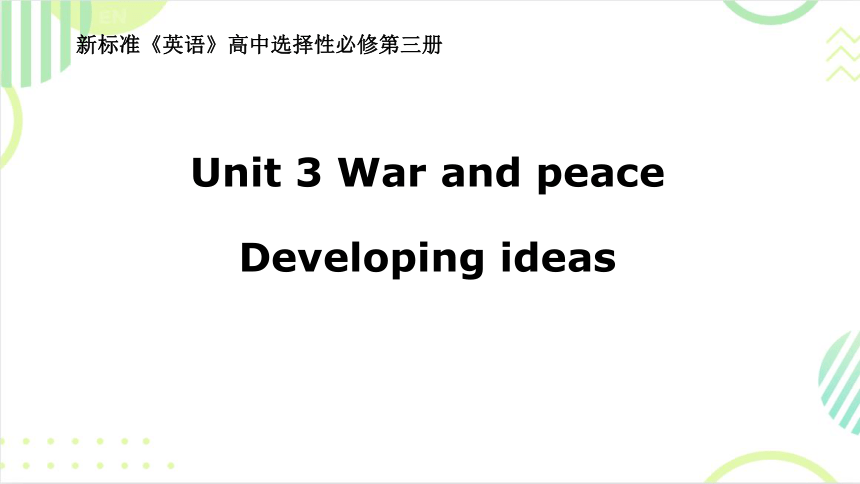 | |
| 格式 | zip | ||
| 文件大小 | 21.7MB | ||
| 资源类型 | 教案 | ||
| 版本资源 | 外研版(2019) | ||
| 科目 | 英语 | ||
| 更新时间 | 2022-08-29 18:44:58 | ||
图片预览

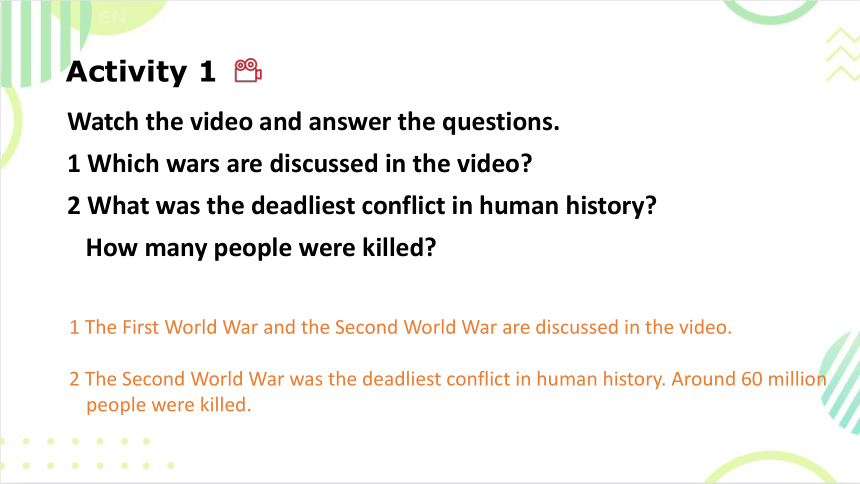
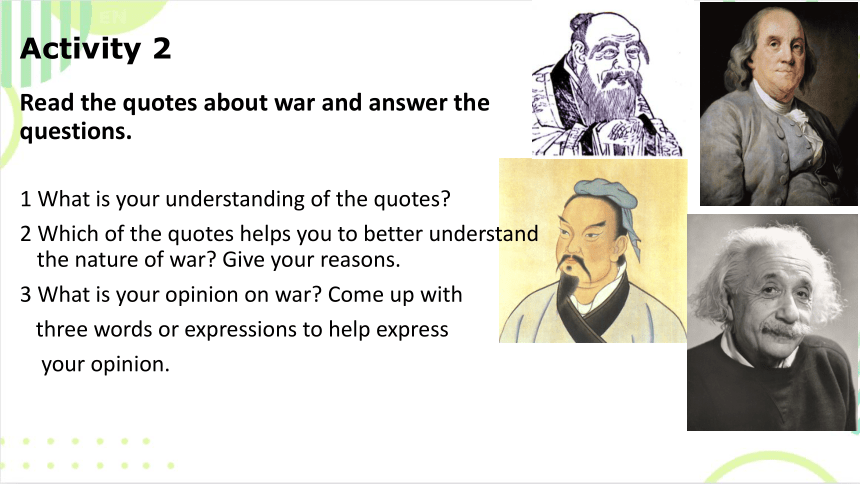

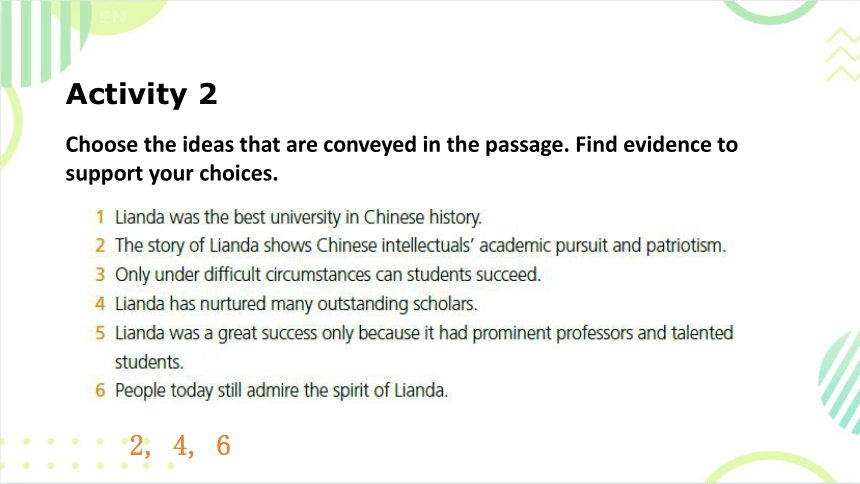
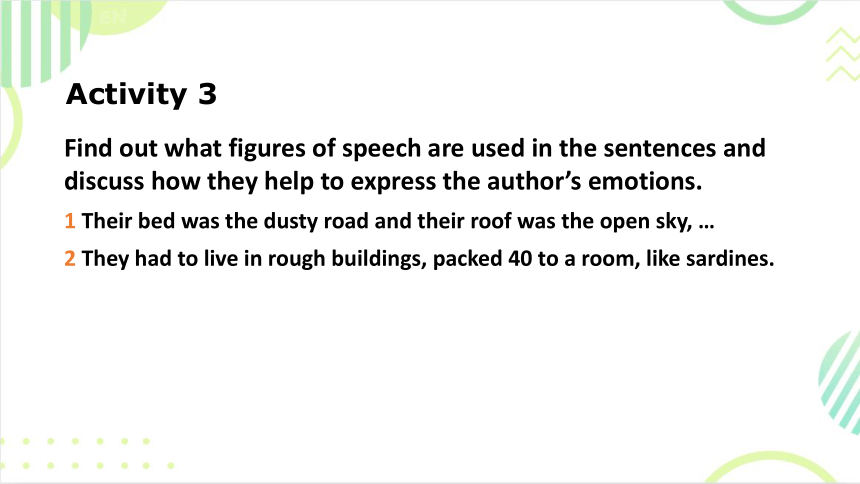
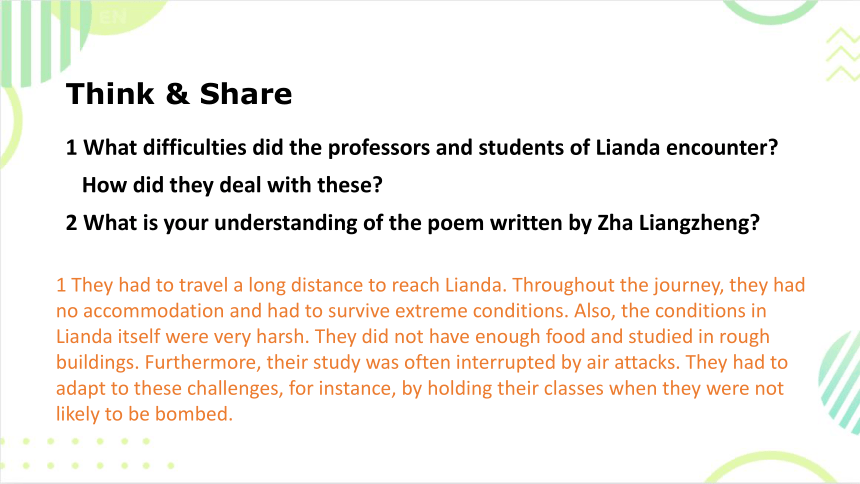
文档简介
(共16张PPT)
Unit 3 War and peace
Developing ideas
新标准《英语》高中选择性必修第三册
Activity 1
Watch the video and answer the questions.
1 Which wars are discussed in the video
2 What was the deadliest conflict in human history
How many people were killed
1 The First World War and the Second World War are discussed in the video.
2 The Second World War was the deadliest conflict in human history. Around 60 million people were killed.
Activity 2
Read the quotes about war and answer the questions.
1 What is your understanding of the quotes
2 Which of the quotes helps you to better understand the nature of war Give your reasons.
3 What is your opinion on war Come up with
three words or expressions to help express
your opinion.
Activity 1 Look at the pictures and answer the questions.
1 What kind of university do you think it is
What do you know about it
2 How is it different from today' s universities
Now read the passage and find out
what is so special about Lianda.
Activity 2
Choose the ideas that are conveyed in the passage. Find evidence to support your choices.
2, 4, 6
Activity 3
Find out what figures of speech are used in the sentences and discuss how they help to express the author’s emotions.
1 Their bed was the dusty road and their roof was the open sky, …
2 They had to live in rough buildings, packed 40 to a room, like sardines.
Think & Share
1 What difficulties did the professors and students of Lianda encounter
How did they deal with these
2 What is your understanding of the poem written by Zha Liangzheng
1 They had to travel a long distance to reach Lianda. Throughout the journey, they had no accommodation and had to survive extreme conditions. Also, the conditions in Lianda itself were very harsh. They did not have enough food and studied in rough buildings. Furthermore, their study was often interrupted by air attacks. They had to adapt to these challenges, for instance, by holding their classes when they were not likely to be bombed.
Think & Share
3 What contribution did Lianda make to the education of the nation
4 In what ways is the theme of war and peace presented differently in
the two reading passages in this unit
3 Many of China’s leading scholars and scientists came from Lianda, including two Nobel Prize winners. Lianda’ s spirit has become the blueprint for all universities in China in the modern era.
4 The passage on the D-Day landings focuses on war as a military operation, and on how dead soldiers are memorialised. The passage on Lianda focuses on how war affected China’s students and academics, and how they were able to achieve excellence in spite of the great difficulties.
Activity 4
Work in groups. Give a talk about the spirit of Lianda.
1 Discuss the questions below.
How can you describe the spirit of Lianda
What examples support your ideas
What can you learn from the story of Lianda
Activity 4
2 Complete the diagram with your ideas and the examples that support them.
Activity 4
3 Give your talk to the class.
Now think about your performance in this activity. Did you actively participate and contribute ideas
Writing about a war hero
Activity 5
Read the introduction to Yang Jingyu and answer the questions.
1 Who was Yang Jingyu
2 Why did Yang decide to let small groups of his men break through the encirclement
3 What did the Japanese find when they killed Yang
4 How would you describe Yang’s spirit in your own words
Yang Jingyu was an anti-Japanese hero, who died in a fight against Japanese
troops.
Because at that time there was a critical lack of supplies.
They found only tree bark, cotton and grass roots, instead of rice in his stomach.
Activity 6
Work in groups. Talk about other war heroes and choose one to write about.
Organise your ideas by completing notes below. Do more research if necessary.
Now write an introduction to the war hero you chose.
Activity 6
参考范文
Dong Cunrui was born into a poor peasant family in Huailai County, Hebei Province on 15 October 1929. In 1945 he joined the Eighth Route Army and in March 1947 he joined the Communist Party of China. On 25 May 1948, the battle for the liberation of Longhua began, and the soldiers of the Chinese People’s Liberation Army (PLA) flooded towards Longhua Middle School, the headquarters of the enemy. Six jets of fire from a bridge blocked the path of the PLA troops. The bridge was a fortress built by the enemy, and the PLA troops were stuck under a small slope. At the critical moment, they needed a soldier to blow up the bridge and open a new road for the whole army. “Captain, let me blow it up!” Dong Cunrui said, and his request was granted. Under the cover of another soldier, he rushed to the bridge, but could not find a place to put the explosives. Dong Cunrui then lifted the explosives in his left hand, lit the blasting fuse and blew up the enemy’s fortress. In doing so, he died a hero.
The story of Dong Cunrui, who gave his life to create a way forward, has been told all over China until today, and has inspired thousands of young people to make sacrifices in defence of our country’s and people’s interests.
Activity 7
Make improvements to each other’s writings and share them with the class.
Unit 3 War and peace
Developing ideas
新标准《英语》高中选择性必修第三册
Activity 1
Watch the video and answer the questions.
1 Which wars are discussed in the video
2 What was the deadliest conflict in human history
How many people were killed
1 The First World War and the Second World War are discussed in the video.
2 The Second World War was the deadliest conflict in human history. Around 60 million people were killed.
Activity 2
Read the quotes about war and answer the questions.
1 What is your understanding of the quotes
2 Which of the quotes helps you to better understand the nature of war Give your reasons.
3 What is your opinion on war Come up with
three words or expressions to help express
your opinion.
Activity 1 Look at the pictures and answer the questions.
1 What kind of university do you think it is
What do you know about it
2 How is it different from today' s universities
Now read the passage and find out
what is so special about Lianda.
Activity 2
Choose the ideas that are conveyed in the passage. Find evidence to support your choices.
2, 4, 6
Activity 3
Find out what figures of speech are used in the sentences and discuss how they help to express the author’s emotions.
1 Their bed was the dusty road and their roof was the open sky, …
2 They had to live in rough buildings, packed 40 to a room, like sardines.
Think & Share
1 What difficulties did the professors and students of Lianda encounter
How did they deal with these
2 What is your understanding of the poem written by Zha Liangzheng
1 They had to travel a long distance to reach Lianda. Throughout the journey, they had no accommodation and had to survive extreme conditions. Also, the conditions in Lianda itself were very harsh. They did not have enough food and studied in rough buildings. Furthermore, their study was often interrupted by air attacks. They had to adapt to these challenges, for instance, by holding their classes when they were not likely to be bombed.
Think & Share
3 What contribution did Lianda make to the education of the nation
4 In what ways is the theme of war and peace presented differently in
the two reading passages in this unit
3 Many of China’s leading scholars and scientists came from Lianda, including two Nobel Prize winners. Lianda’ s spirit has become the blueprint for all universities in China in the modern era.
4 The passage on the D-Day landings focuses on war as a military operation, and on how dead soldiers are memorialised. The passage on Lianda focuses on how war affected China’s students and academics, and how they were able to achieve excellence in spite of the great difficulties.
Activity 4
Work in groups. Give a talk about the spirit of Lianda.
1 Discuss the questions below.
How can you describe the spirit of Lianda
What examples support your ideas
What can you learn from the story of Lianda
Activity 4
2 Complete the diagram with your ideas and the examples that support them.
Activity 4
3 Give your talk to the class.
Now think about your performance in this activity. Did you actively participate and contribute ideas
Writing about a war hero
Activity 5
Read the introduction to Yang Jingyu and answer the questions.
1 Who was Yang Jingyu
2 Why did Yang decide to let small groups of his men break through the encirclement
3 What did the Japanese find when they killed Yang
4 How would you describe Yang’s spirit in your own words
Yang Jingyu was an anti-Japanese hero, who died in a fight against Japanese
troops.
Because at that time there was a critical lack of supplies.
They found only tree bark, cotton and grass roots, instead of rice in his stomach.
Activity 6
Work in groups. Talk about other war heroes and choose one to write about.
Organise your ideas by completing notes below. Do more research if necessary.
Now write an introduction to the war hero you chose.
Activity 6
参考范文
Dong Cunrui was born into a poor peasant family in Huailai County, Hebei Province on 15 October 1929. In 1945 he joined the Eighth Route Army and in March 1947 he joined the Communist Party of China. On 25 May 1948, the battle for the liberation of Longhua began, and the soldiers of the Chinese People’s Liberation Army (PLA) flooded towards Longhua Middle School, the headquarters of the enemy. Six jets of fire from a bridge blocked the path of the PLA troops. The bridge was a fortress built by the enemy, and the PLA troops were stuck under a small slope. At the critical moment, they needed a soldier to blow up the bridge and open a new road for the whole army. “Captain, let me blow it up!” Dong Cunrui said, and his request was granted. Under the cover of another soldier, he rushed to the bridge, but could not find a place to put the explosives. Dong Cunrui then lifted the explosives in his left hand, lit the blasting fuse and blew up the enemy’s fortress. In doing so, he died a hero.
The story of Dong Cunrui, who gave his life to create a way forward, has been told all over China until today, and has inspired thousands of young people to make sacrifices in defence of our country’s and people’s interests.
Activity 7
Make improvements to each other’s writings and share them with the class.
